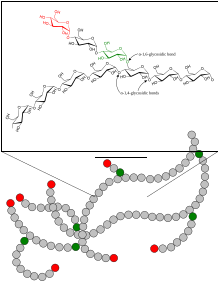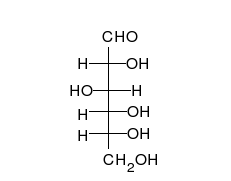Glycogen storage disease type IX
| Glycogen storage disease IX | |
|---|---|
 | |
| Glycogen structure | |
| Symptoms | Enlarged liver[1] |
| Causes | Mutations in PHKA1, PHKA2, PHKB, or PHKG2 genes[2] |
| Diagnostic method | CBC, Urinalysis[1][3] |
| Treatment | Physical therapy, follow metabolic nutritionist[1] |
Glycogen storage disease type IX is a
Signs and symptoms
The signs and symptoms in glycogen storage disease type IX include:[1]
- Enlarged liver
- Slowed growth
- Motor development delay (mild)
- Low blood sugar accompanied by ketosis
- Lack of muscle tone
Most of these signs and symptoms diminish as adulthood sets in.[1]
Genetics
Glycogen storage disease type IX can be inherited via:[2][4]
- .
Diagnosis

The diagnosis of glycogen storage disease IX consists of the following:[1][3]
- Complete blood count
- Urinalysis
- Histologicalstudy of the liver (via biopsy)
- Genetic testing
- Physical exam
Types
There are two types of this inherited condition, glycogen storage disease IXa1 and glycogen storage disease IXa2 that affect the liver of an individual.[6] Mutations in PHKA2 have been seen in individuals with glycogen storage disease IXa2.[medical citation needed]
Management

The management of Glycogen storage disease IX requires treatment of symptoms by frequent intake of complex carbohydrates and protein to combat the low blood sugar. A nutritionist will advise on suitable diets. Liver function is regularly monitored and problems managed as they arise. However, liver problems have only been successfully treated by a
See also
References
- ^ PMID 21634085. update 2011
- ^ a b "Glycogen storage disease type IX". Genetics Home Reference. Retrieved 2016-08-06.
- ^ a b Tidy, Colin (21 August 2014). "Glycogen Storage Disorders. GSD information and treatment". Patient Platform. Retrieved 6 August 2016.
- ^ "Glycogen storage disease due to phosphorylase kinase deficiency". Orphanet. Retrieved 2016-08-06.
- ISBN 9783319146218. Retrieved 6 August 2016.
- ^ "Glycogen storage disease IX". OMIM. Johns Hopkins University. Retrieved 2016-08-06.
- ISBN 9783662031476. Retrieved 6 August 2016.
Further reading
- Johnson, Abiodun O.; Goldstein, Jennifer L.; Bali, Deeksha (July 2012). "Glycogen Storage Disease Type IX". Journal of Pediatric Gastroenterology and Nutrition. 55 (1): 90–92. PMID 21857251.
- Özen, Hasan (14 May 2007). "Glycogen storage diseases: New perspectives". World Journal of Gastroenterology. 13 (18): 2541–2553. PMID 17552001.
- Albash, Buthainah; Imtiaz, Faiqa; Al-Zaidan, Hamad; Al-Manea, Hadeel; Banemai, Mohammed; Allam, R.; Al-Suheel, Ali; Al-Owain, Mohammed (2014). "Novel PHKG2 mutation causing GSD IX with prominent liver disease: report of three cases and review of literature". European Journal of Pediatrics. 173 (5): 647–653. S2CID 37564174.
- Stoler, edited by Raymond R. Tubbs, Mark H.; Stoler, Mark H. (2009). Cell and tissue based molecular pathology (1st ed.). Philadelphia: Churchill Livingstone/Elsevier. ISBN 978-1437719482. Retrieved 6 December 2017.)
{{cite book}}:|first1=has generic name (help)CS1 maint: multiple names: authors list (link
External links
 Media related to Glycogen storage disease type IX at Wikimedia Commons
Media related to Glycogen storage disease type IX at Wikimedia Commons
